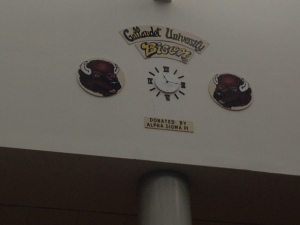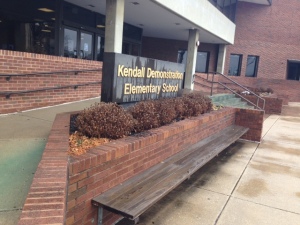 Well, the Deaf Education faculty certainly had a wonderful and productive week in Washington DC, at the Association for College Educators of the Deaf and Hard of Hearing (ACE-DHH)
Well, the Deaf Education faculty certainly had a wonderful and productive week in Washington DC, at the Association for College Educators of the Deaf and Hard of Hearing (ACE-DHH)  conference! What a great time, and I am so happy it was on Gallaudet University campus, which I got to visit for the first time! Dr. Baker had already been on campus since last Friday working on the Visual Communication and Sign Language checklist (VCSL), filming ASL directions for implementation of this amazing assessment tool designed to evaluate the communication abilities of young Deaf children. The checklist will be distributed by Visual Language and Visual Learning (VL2), a research group sponsored by the National Science Foundation. I (Jessica!) did not arrive until the following week, just a day before the conference began. But we spent that day productively – we had a meeting with some colleagues at Gallaudet and Lamar Universities to discuss a research project we are working on that will hopefully lead to some insights into how to better teach reading to young d/Deaf and hard of hearing children!
conference! What a great time, and I am so happy it was on Gallaudet University campus, which I got to visit for the first time! Dr. Baker had already been on campus since last Friday working on the Visual Communication and Sign Language checklist (VCSL), filming ASL directions for implementation of this amazing assessment tool designed to evaluate the communication abilities of young Deaf children. The checklist will be distributed by Visual Language and Visual Learning (VL2), a research group sponsored by the National Science Foundation. I (Jessica!) did not arrive until the following week, just a day before the conference began. But we spent that day productively – we had a meeting with some colleagues at Gallaudet and Lamar Universities to discuss a research project we are working on that will hopefully lead to some insights into how to better teach reading to young d/Deaf and hard of hearing children!

Dr. Baker and I were also lucky to get to visit Kendall Demonstration Elementary School – KDES, the elementary school on Gallaudet University’s campus. Although they were busy, as is usual in elementary schools, we were lucky enough to get a tour of the school from one of the administrators. The school itself is beautiful, so many open spaces designed with the visual needs of Deaf children in mind. We also learned that they have a mandatory after school program for all students – which means that the students at KDES are in school until 5:30 every day! Can you imagine the opportunities for cognitive and linguistic growth these children have?

And while we were leaving the school, we saw a flyer stand full of research briefs by VL2, one of which was authored by our very own Dr. Sharon Baker! It is about the importance and impact of fingerspelling on Deaf children, and has been translated into a number of languages. How exciting to see the work we are doing impact people not only across the United States, but across the world! KDES was not our only tour however – the VL2 labs very generously opened their doors to conference attendees, and we were able to see the space and researchers that have made so many contributions to research related to Deafness.

That evening I was very fortunate to be able to attend a very exciting talk with some really excellent people. Dr’s Marlon Kuntze [see picture to the left], Ben Bahan [see picture below on the right] (who should be recognizable to those who learned ASL using the Signing Naturally series – at least the older version!), H-Dirksen Bauman, Beth Benedict and Catherine O’Brien all came for a panel discussion on the concept of “Deaf Gain” –
 the opposite of hearing loss! This discussion explored not only what individual students gain from their Deaf experience (linguistically, culturally, cognitively), but also what the world gains from the contribution of Deaf individuals (notably but not limited to: the football huddle, hand signals in baseball, closed captioning, and much more!) The conversation was lively, and I appreciated being able to see such amazing and creative minds discussing this important way of looking at Deafness.
the opposite of hearing loss! This discussion explored not only what individual students gain from their Deaf experience (linguistically, culturally, cognitively), but also what the world gains from the contribution of Deaf individuals (notably but not limited to: the football huddle, hand signals in baseball, closed captioning, and much more!) The conversation was lively, and I appreciated being able to see such amazing and creative minds discussing this important way of looking at Deafness.
The next day brought a number of wonderful presentations and opportunities to talk with others in the field. Dr. Baker presented a poster with colleagues from other universities about fingerspelling, a topic that is not frequently discussed in the literature. I attended a session about using Graphic Novels in a summer reading camp for Deaf students by Caroline Guardino of University of North Florida, and came away a lot of ideas that I hope to use in our tutoring program here at TU! I also had the opportunity to reconnect with faces from the past – a student I taught at Alaska State School for Deaf and Hard of Hearing is currently a junior at Gallaudet studying Social Work, and my student teaching supervisor and advisor from my alma mater, Flagler College, was also in attendance. A TU grad from last year, Stephanie Voss, also took time out from her master’s program to visit us on campus!

Gallaudet University Press had a table with lots of books that have recently been published in our field, and needless to say I’ve come away with a wish list a mile long. (That also includes my love of some ASL number handshape clocks for sale in the bookstore!).
We also got to attend the Bilingual Special Interest Group meeting, a further discussion of Deaf Gain and how we can bring the concept of Deaf Gain into classrooms with Deaf children – capitalizing on their strengths and experiences as we teach them in multiple areas, including mathematics, literacy, and technology. These conversations were fascinating and important, and I count myself lucky to have been among colleagues who feel so passionately about these issues.
Finally, I presented this very afternoon on the use of translation during guided reading with Dr. Kuntze (of the Deaf Gain talk!) – we have been watching videos of children who are reading with their teachers and the type of translation they are engaging in – most commonly they are reading word for word, but we have some wonderful instances of children translating phrases and even complete sentences from English into beautiful ASL – a sure sign that students understand what they are reading!
I am writing this post from the Reagan National Airport in DC, reflecting on what an amazing time we had this week. Although it was very busy, it is so wonderful to be among passionate, committed educators who work with Deaf students (and those who are working with people who want to become teachers of Deaf students!). Although our work day to day in Tulsa can feel far away from others in the field, it is wonderful to know that we have colleagues that share our perspectives and experiences (and others who challenge these perspectives and experiences!). Monday, it’s back to classes and the reading clinic, but with a fresh perspective and new ideas from some amazing colleagues.

![photo[1]](https://deafedtu.wordpress.com/wp-content/uploads/2014/03/photo11.jpg?w=217&h=300)














